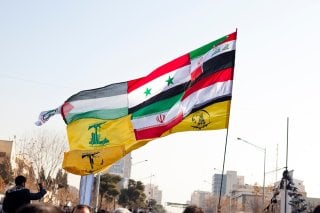Rany Ballout

Together with Iran-backed regional militias, including Hamas in the Palestinian territories, the Houthis in Yemen, the Islamic Resistance in Iraq, and other smaller armed groups in Syria, Hezbollah in Lebanon forms Iran’s so-called “Axis of Resistance,” an informal alliance that Iran has built up across the Middle East since the inception of the Islamic Republic. Its objectives are to reduce and eliminate the United States’ presence in the Middle East and destroy Israel. Hezbollah has recently initiated its “unity of fronts” strategy to strengthen operational coordination among the various member militias within the axis of resistance and position battlefield capabilities to surround Israel’s borders in anticipation of future battles.
Amid persistent speculation of a sudden wider conflagration at the Lebanon-Israel border, Israel has shown readiness to undertake escalatory risks by conducting deeper strikes inside Lebanon and Syria and high-profile assassinations of senior commanders of Iran and its proxies. Hezbollah appears to be continuously reorienting its rhetoric surrounding its initiated “unity of fronts.” New arguments suggest that it is not only a military strategy but also an ideological, media, and spiritual strategy aimed at resisting any attempt to break its unity. This expanded rhetoric points to shifting propaganda, reflecting continuous efforts to strengthen deliberations about the outcome of its ongoing fighting with Israel, as well as its strategic objective of winning the media battle.
These arguments came from Lebanese analyst and longtime Al Manar’s house commentator, Salem Zahran, who is considered one of the closest commentators to Hezbollah (and broadly the Syrian regime of Bashar al-Assad). In a recent interview with Al Mayadeen TV, Zahran elaborated on the “unity of fronts” strategy as part of his attempts to demonstrate its part in the ongoing Israel-Hamas war while underscoring the significance of winning the media battle against Israel and the United States. Zahran’s argument focused on what he claimed as Hezbollah’s successful psychological warfare in its historical conflict with Israel while portraying Hezbollah’s secretary-general Hassan Nasrallah as a master of psychological warfare.
Zahran’s rhetorical characterization of the “unity of fronts” strategy aligns with a shift in Nasrallah’s more recent speeches in the wake of Israel’s recent escalation campaign against Iran and its allies in the region. This included the recent airstrike reportedly by Israel on the consular section of the Iranian embassy in Damascus that killed seven high-ranking Islamic Revolutionary Guard Corps officers. Nasrallah has repeatedly relayed any deliberations about Hezbollah’s current fighting with Israel and the war in Gaza to developments on the battlefield, stating that it is the ultimate arbiter of the current conflict. His most recent speeches reflect a preoccupation with the public debate in Lebanon surrounding the prolonged course of the fighting and its implications, with deep concerns about the recent escalation and the growing possibility of a full-scale war. Notably, he grappled with the scope and general direction of the media and social media campaigns in their coverage and discussions of the war’s course.
In a speech in March, Nasrallah complained about what he saw as a renewed public and media campaign waged in recent weeks against Hezbollah by opponents in Lebanon that included party leaders, politicians, analysts, commentators, and social media activists who questioned the validity and effectiveness of Hezbollah’s cross-border fighting with Israel. In response, Nasrallah countered by presenting his own analysis of Israeli official statements and media, which he described as demonstrating substantial weaknesses of the Israeli campaign and heavy losses incurred by its military. In a more recent speech last week following the alleged Israeli attack on Iranian senior leaders in Damascus, Nasrallah went even further, calling on all media outlets and platforms supportive of the “resistance axis” to deploy all available means to illustrate and highlight the resistance’s historical achievements as a response to what he described as “diminishers” and “hypocrites” in the Arab and Muslim world who spotlighted Hezbollah’s losses and ignored its achievements.
Whether under direct guidance from Nasrallah or as a reflection of groupthink, many commentators known to be close to Hezbollah have intensified their media appearances and become more combative in endorsing Nasrallah and other Hezbollah leaders’ arguments since the group initiated its cross-border attacks on Israel on October 8. They also generally defend Hezbollah’s conduct in the Israel-Hamas war as part of a larger and calibrated messaging effort to win the media battle in Lebanon. Whether in deriding their opponents’ arguments or even accusing them of treason with Israel, many commentators have stepped up their messaging using TV interviews, podcasts, press coverage, and social media to help propel Hezbollah’s version of its current combat with Israel and propagate their pro-Hezbollah views. These commentators generally claim that the United States has been extensively trying to break this “unity of fronts” but failed so far.
Nasrallah began referring to the “unity of fronts” in his speeches last year, primarily focusing on its meaning on the battlefield, with many discussing the prospect of its operational effectiveness against Israel. Some argue that Iran’s axis of resistance has matured into a cohesive alliance network by having the ability to strategically coordinate between independent operations by its proxies, as seen in the ongoing Gaza war. However, others contend that the war in Gaza has demonstrated that Iran has not yet achieved operational control over its militias, with auxiliaries such as the Houthis remaining unmanageable and retaining complete freedom of action. It appears that it is not yet time to draw definitive conclusions.
The expanded rhetoric around the “unity of fronts,” with a focus on winning the media battle, aims at reinforcing deterrence in the face of Israel’s recent escalation against Iran and its proxies. Whether Iran will conduct a significant attack on Israel in retaliation for the airstrike on its consulate in Syria or opt for symbolic attacks similar to its reaction to other high-profile assassinations, such as the killing of Soleimani in January 2020, its long-standing strategy of pursuing “strategic patience” by establishing deterrence through contained strikes now appears to be in doubt.
No comments:
Post a Comment